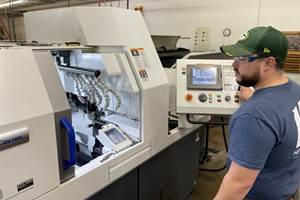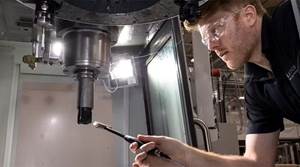Scalable Measurement And Quality
Machine shop owners face a fundamental conflict in their efforts to make metrology an integral part of manufacturing processes. On one hand, the critical relationship between quality and profitability makes metalworking professionals reluctant to change tried-and-true methods. On the other hand, however, the drive for better productivity demands that every aspect of the manufacturing process be rationalized and increasingly divorced from the realm of human subjectivity.
Share





Machine shop owners face a fundamental conflict in their efforts to make metrology an integral part of manufacturing processes. On one hand, the critical relationship between quality and profitability makes metalworking professionals reluctant to change tried-and-true methods. This reluctance is reinforced by the fact that the command language for each type of metrology equipment is likely to be unique and based on the proprietary system of a particular manufacturer. Although the emerging DMIS standard was developed to mitigate this problem, the language barrier continues to complicate efforts to integrate measurement into larger networks.
On the other hand, however, the drive for better productivity demands that every aspect of the manufacturing process be rationalized and increasingly divorced from the realm of human subjectivity. While improvements in machine tools have yielded more automated metalworking processes, measurement and quality control continue to represent detours in many manufacturing operations. Although it’s common for the largest manufacturers to use sophisticated quality control based on Statistical Process Control (SPC) systems, smaller manufacturers and job shop owners may perceive this approach as unnecessary or prohibitively expensive.
Siemens Measurement Systems (Spring House, Pennsylvania) addresses these concerns by offering the Criterion SPC Vantage software tool package. The ten component modules of this suite allow users to establish a complete Quality Information System (QIS) that may be networked company-wide. The software’s open architecture and uniform operator interfaces allow data to be accepted from a variety of sources regardless of the particular format. To facilitate international applicability as well, the major components of this program may be operated in English, German, Spanish and French.
Based on the Windows NT platform, the software is compatible with off-the-shelf PC hardware, third-party measuring devices and CNC controls. The program’s administrative module enables the user to establish classifications and to create data hierarchies for organizing the entire database. A separate data-acquisition module facilitates manual input of information, as well as accepting automatically collected data from predetermined sources. This module automatically categorizes data by product and process, as well as by any number of user-defined tags. It also provides online statistical analysis as data is collected. The software’s analytic module then processes this historical database, creating charts and reports that illustrate quality trends in the ongoing manufacturing process.
The program uses a relational database that can be read by other report writers and query engines. It also generates process capability charts that relate actual output to specific sigma standards. In addition to processing quantitative data, the program also allows inputting qualitative assessments that include non-dimensional measurements such as temperature, pressure, torque and physical attributes.
The Criterion system is scalable for manual, semi-automatic or fully automated operations that comprise various types of measurement devices. This expandable system provides the flexibility to establish a QIS for any size or type of manufacturing operation. The program is designed to integrate numerous types of data into a common system that allows measurement and quality information to be readily accessed and shared throughout a manufacturing organization.
This system provides metalworking professionals with the tools to verify in-process parts and to control the parameters of their manufacturing processes to attain specific quality goals. Assessments of control status and quality trends are made in real time as the data is collected. At regular intervals as desired, a manufacturer may then perform more detailed SPC analysis.
Metalworking professionals who already have begun to integrate measurement and quality functions into their automated processes often discuss the importance of the confidence factor in making this decision. A significant aspect of this confidence consists in the conviction that all components in the manufacturing system will be able to work together. By creating a software package that accommodates a shop’s existing hardware and software systems, Siemens brings sophisticated QIS capability within the reach of many firms.
Related Content
Continuous Improvement and New Functionality Are the Name of the Game
Mastercam 2025 incorporates big advancements and small — all based on customer feedback and the company’s commitment to keeping its signature product best in class.
Read MoreCutting Part Programming Times Through AI
CAM Assist cuts repetition from part programming — early users say it cuts tribal knowledge and could be a useful tool for training new programmers.
Read MoreERP Provides Smooth Pathway to Data Security
With the CMMC data security standards looming, machine shops serving the defense industry can turn to ERP to keep business moving.
Read MoreHow to Mitigate Chatter to Boost Machining Rates
There are usually better solutions to chatter than just reducing the feed rate. Through vibration analysis, the chatter problem can be solved, enabling much higher metal removal rates, better quality and longer tool life.
Read MoreRead Next
Machine Shop MBA
Making Chips and 91ÊÓƵÍøÕ¾ÎÛ are teaming up for a new podcast series called Machine Shop MBA—designed to help manufacturers measure their success against the industry’s best. Through the lens of the Top Shops benchmarking program, the series explores the KPIs that set high-performing shops apart, from machine utilization and first-pass yield to employee engagement and revenue per employee.
Read MoreLast Chance! 2025 Top Shops Benchmarking Survey Still Open Through April 30
Don’t miss out! 91ÊÓƵÍøÕ¾ÎÛ's Top Shops Benchmarking Survey is still open — but not for long. This is your last chance to a receive free, customized benchmarking report that includes actionable feedback across several shopfloor and business metrics.
Read MoreAMRs Are Moving Into Manufacturing: Considerations for Implementation
AMRs can provide a flexible, easy-to-use automation platform so long as manufacturers choose a suitable task and prepare their facilities.
Read More





















